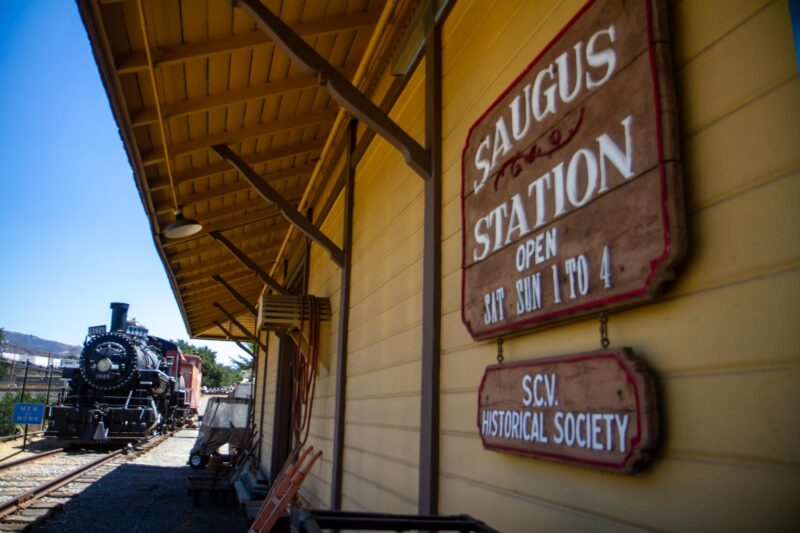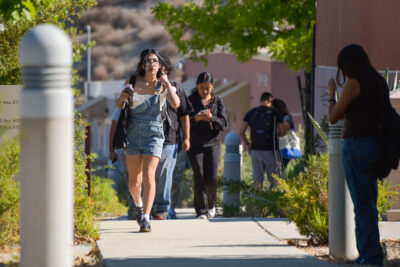Some time back, they found a type of wooden angled counter. According to Mike Jarel, a former Southern Pacific engineer and historical consultant, the wooden piece was among a bunch of other artifacts at the Saugus Train Station they were going through as they began the remodel. They had no idea what it was or where it was going.
Then they were watching the 1954 Frank Sinatra movie “Suddenly,” which heavily featured the station as a backdrop, and they spotted it.
“There’s a scene where a man comes out of the baggage room right there,” Jarel said, pointing from the station agent’s office in the Saugus Station to the baggage room down the hall. “He walks right by here, the camera sweeps, and there it was.”
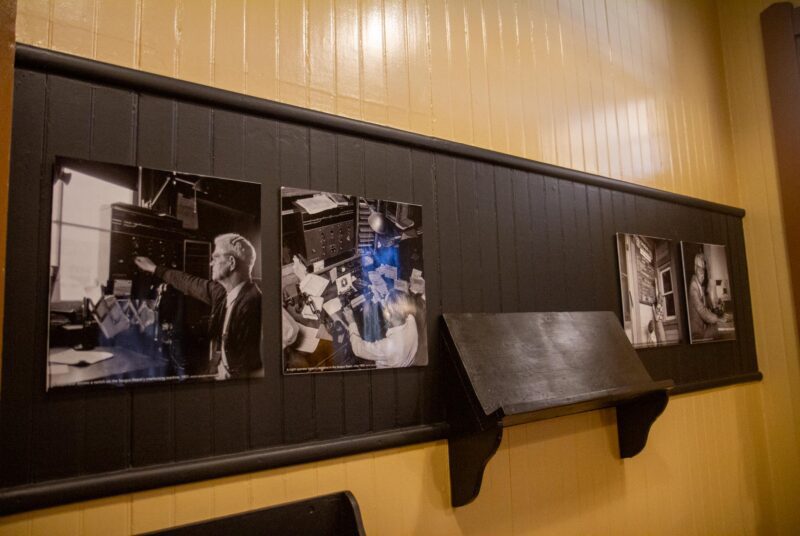
Jarel pointed to the angled counter mounted on the wall. It looked like it might’ve once held a logbook or something similar. He then showed a break in the wooden molding and explained that when he and others began the station remodel, they held the angled counter they’d found up to the wall — just as it appeared in the movie — and it fit perfectly between the gaps in the molding.
The Santa Clarita Valley Historical Society hosted a soft reopening of the Saugus Train Station Museum on Saturday at the Santa Clarita History Center in Old Town Newhall. According to Carol Rock, marketing director of the Historical Society, the train station closed down during the COVID-19 pandemic and, since then, has been undergoing a remodel. The completion of the station agent’s office is part of phase one of the overall restoration.
“The difference between the old train station and the one we’re opening on Saturday,” she wrote in an email before the event, “is that we are only featuring Southern Pacific and Union Pacific equipment … In the old days (of the museum), we would take and display pretty much anything that had to do with a train, regardless of the rail line or part of the country it serviced. Now it’s hyperlocal.”
Rock added that Southern Pacific built the station in 1888, and only Southern Pacific and Union Pacific used the station. The station agent’s office is currently filled with authentic railroad artifacts, artwork depicting the “meeting of the rails” at the Lang Station in the eastern Santa Clarita Valley, a model of that station, items from the relocation of the Saugus station in 1980 from its original location near the Saugus Café to its current location, and details about the first woman station agent.
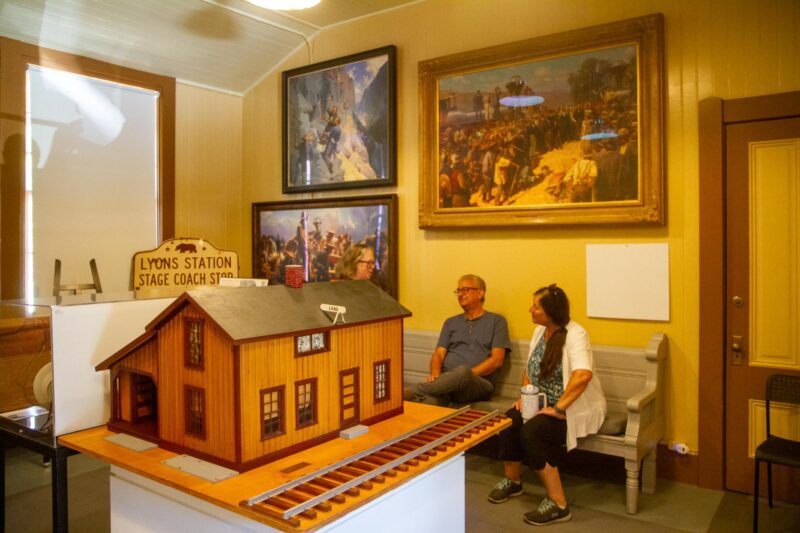
According to Alan Pollack, president of the Historical Society, the Saugus Train Station will be completed in three phases. He and others were anxious to reopen so the public could see what they’d been working on.
“We are so happy to finally be able to open to the public,” he said at the event on Saturday. “We have plans for much more to come.”
Leon Worden, secretary of the SCV Historical Society board of directors, who also coordinated most of the restoration work on the station and even completed some of the work himself, said he and others are remodeling the place to look like it did during the era between 1917 and 1958.
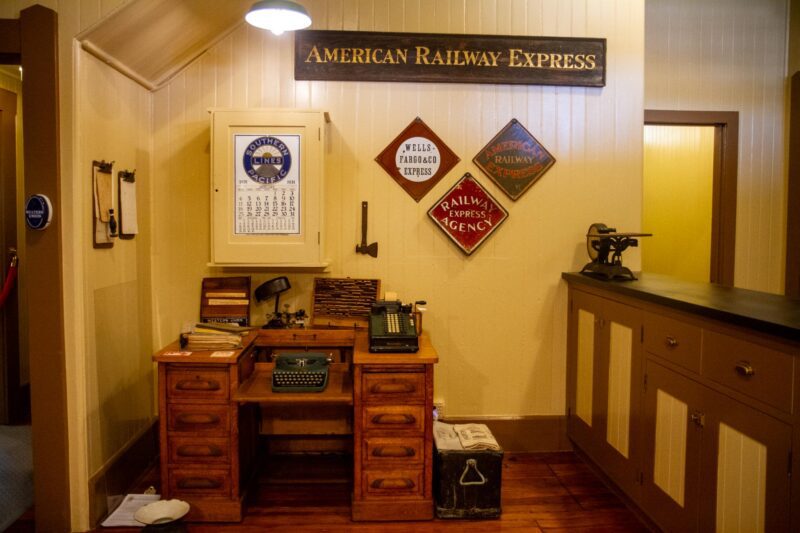
Worden described the great effort he and others put into finding even the right color of paint for the walls.
“Mike Jarel, who’s our SP (Southern Pacific) guru, has been on the board of the Southern Pacific Historical and Technical Society,” Worden said. “He was a locomotive engineer for 40 years on the SP and the UP (Union Pacific). He’s tight with all of the big SP historians, and one of them, by the name of John Signor up in Northern California, had the only known set of actual original Southern Pacific paint chips. They call them color drift panels.”
Southern Pacific, Worden said, had strict specifications for everything — from locomotive parts to toilet hardware. Among the preserved materials were color drift panels containing the original paint swatches used when the station was built. Worden displayed the swatches, still in perfect condition and neatly stored in envelopes. Until a few years ago, they’d been kept in a shop in Sacramento.
The paint that visitors see at the museum wasn’t matched to an old, faded piece of the station — because, as Worden explained, those wouldn’t reflect the building’s original color. Instead, the color is authentic, exactly as it was when Southern Pacific built the station in 1888.
Santa Clarita Mayor Pro Tem Laurene Weste attended the station event on Saturday. She said that Worden and others truly valued and paid close attention to those kinds of painstaking details.
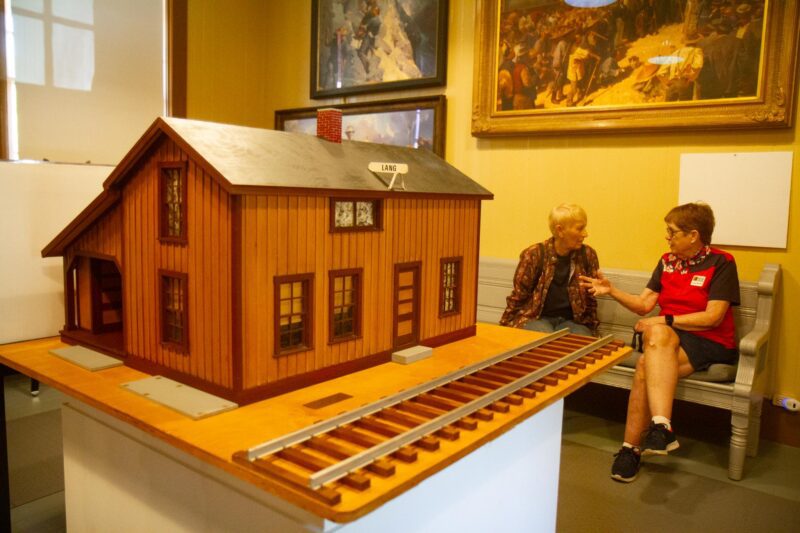
The station agent’s office, for example, featured a passenger counter and, on the other side of the office, a freight counter that historians recreated from original station plans.
But the rest of the station, according to Worden, is all original.
The office is furnished with items typical of the time period the historians sought to recreate. Details like a vintage typewriter and delivery hoops are on display for visitors to see.
Jarel talked a bit about how a station agent would’ve utilized such items.
“In a small-town depot, the agent wore many hats,” he said. “In a large city terminal, the agent would just do agent’s work, but he also communicated with the train dispatcher. The dispatcher could dictate what were called train orders that would be typed up, folded up and put onto these delivery forks or, earlier, those hoops.”
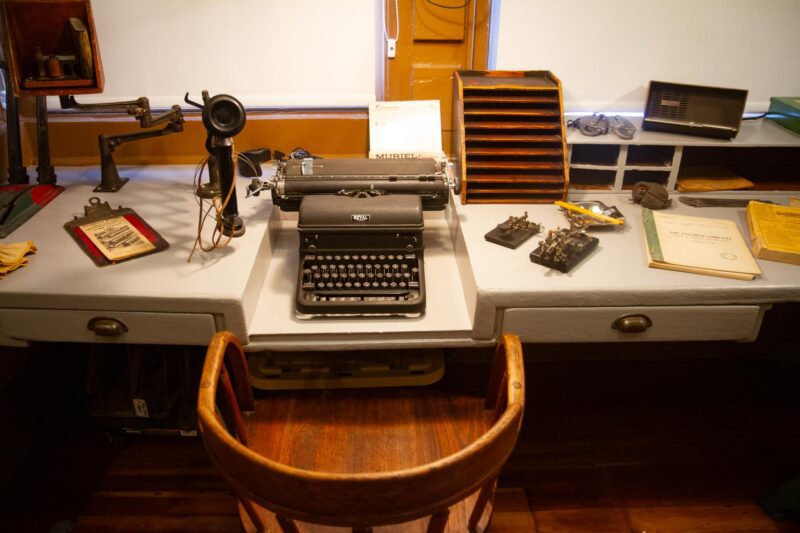
Jarel pointed to a wall in the office, where sticks were mounted — some with prongs on the ends, others with hoops. He said that agents used sticks like those to hang messages for passing trains to catch as they went by. That, he said, was how communication worked.
Barbara Martinelli, docent coordinator on Saturday, and others showed guests through the station, and then they’d lead them to the locomotive outside where those who wanted could climb aboard and ring the bell.
Eventually, guests will also be able to tour the inside of the train caboose. But that project is part of another phase of the restoration.
In the meantime, the public is welcome to see what Saugus Station looked like during its busiest days. According to Worden, it’ll be open on Saturdays from 1 to 4 p.m., with Sunday hours expected to be added in the future.
For more information about the Santa Clarita History Center, go to SCVHS.com.

